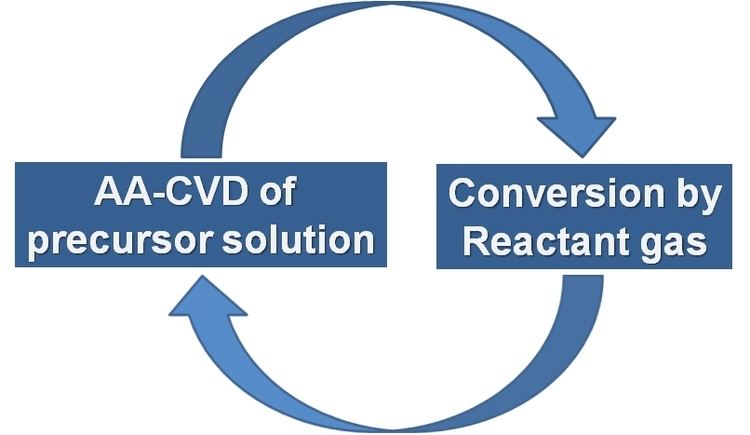 | ||
Ion layer gas reaction (ILGAR®) is a non-vacuum, thin-film deposition technique developed and patented by the group of Professor Dr. Christian-Herbert Fischer at the Helmholtz-Zentrum Berlin for materials and energy in Berlin, Germany. It is a sequential and cyclic process that enables the deposition of semiconductor thin films, mainly for (although not restricted to) photovoltaic applications, specially chalcopyrite absorber layers and buffer layers. The ILGAR technique was awarded as German High Tech Champion 2011 by the Fraunhofer Society.
Contents
ILGAR is a chemical process that allows for the deposition of layers in a homogenous, adherent and mechanically stable form without using vacuum or high temperatures. It is a sequential and cyclic process which can be automated and scaled up. It consists basically of the following steps:
These steps are repeated until the desired layer thickness is obtained.
In the case of spray-ILGAR, the spray deposition of the ionic layer is performed using similar equipment to atmospheric pressure aerosol assisted chemical vapour deposition or spray pyrolysis.
Spray pyrolysis can be regarded as a simplified version of the spray ILGAR process, where there is no reaction of the precursor layer with a reactant gas.
The cyclical nature of this process makes it similar to atomic layer deposition (ALD), which is also used for buffer layer deposition.
Applications
The applications of the ILGAR and spray-pyrolysis techniques at the Helmholtz-Zentrum Berlin lie mainly in the field of chalcopyrite thin film solar cells, although these techniques can be used for other applications involving substrate coating with thin films. The following list summarizes the applications of these techniques:
ILGAR as a replacement for chemical bath deposition
The advantage of ILGAR compared to chemical bath deposition (CBD) lies in the fact that it is easier to deposit high quality precursor layers and convert them to the chalcogenide than to directly deposit chalcogenide thin films. It is also possible to grow films with graded properties or compositions by changing the precursors or the process parameters. Furthermore, ILGAR is an in-line process whereas chemical bath deposition is intrinsically a batch process.
